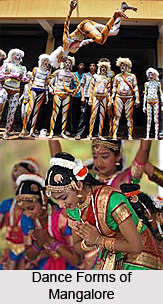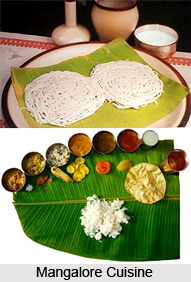 Culture of Mangalore deals with the South Indian dance-drama, dances theatres, and last but not the least is cuisine which are globally famous. The most famous dance-drama in Mangalore and its adjacent area is Yakshagana. Yakshagana is a theatre form that combines dance, music, dialogue, costume, make-up, and stage techniques with a unique style and form. This theatre style resembles the Western opera. Yakshagana is traditionally presented from dusk to dawn.
Culture of Mangalore deals with the South Indian dance-drama, dances theatres, and last but not the least is cuisine which are globally famous. The most famous dance-drama in Mangalore and its adjacent area is Yakshagana. Yakshagana is a theatre form that combines dance, music, dialogue, costume, make-up, and stage techniques with a unique style and form. This theatre style resembles the Western opera. Yakshagana is traditionally presented from dusk to dawn.
Dances of Mangalore
The Yakshagana is a night-long dance and drama performance, is held in Mangalore. while Pilivesha, which is known as the tiger dance, a folk dance unique to the city, is performed during Dussehara and Janmashtami.
Karadi Vesha, the bear dance is another well known dance performed during Dasara. Paddanas, the ballad-like epics passed on through generations by word of mouth are sung by a community of impersonators in Tulu and are usually accompanied by the rhythmic drum beats. The Beary dance is unique dance showcasing the folk traditions. Beary Dances are reflected in such folk songs as Kolkai, which is sung during Kolata, a valour folk-dance during which sticks used as properties, Unjal pat, a traditional lullaby, Moilanji pat, and Oppune pat, sung at weddings. The Evkaristik Purshanva is an annual Catholic religious procession led on the first Sunday of each New Year.
Festivals of Mangalore
 Most of the popular Indian festivals are celebrated in the city, the most important being Dussehra, Diwali, Christmas, Easter, Eid-ul-fater, and Ganesh Chaturthi. Kodial Theru, also known as Mangaluru Rathotsava (Mangalore Car Festival) is a festival unique to the Goud Saraswat Brahmin community, and is celebrated at the Sri Venkatramana Temple. The unique festivals of Mangalorean Catholics community include Monti Fest or Mother Mary`s feast, which celebrates the Nativity feast and the blessing of new harvests. Aati, a festival worshiping Kalanja, a patron spirit of the city, occurs during the Aashaadha month of Hindu calendar. The festivals in Mangalore such as Karavali Utsav and Kudlostava are highlighted by national and state-level performances in dance, drama and music. Bhuta Kola is usually performed by the Tuluva community at night. Nagaradhane is performed in the city in praise of the serpent king, who is said to be the protector of all snakes. Hindu Kori Katta, a religious and spiritual cockfight, is held at the Hindu temples of Mangalore and also allowed if organised as part of religious or cultural events.
Most of the popular Indian festivals are celebrated in the city, the most important being Dussehra, Diwali, Christmas, Easter, Eid-ul-fater, and Ganesh Chaturthi. Kodial Theru, also known as Mangaluru Rathotsava (Mangalore Car Festival) is a festival unique to the Goud Saraswat Brahmin community, and is celebrated at the Sri Venkatramana Temple. The unique festivals of Mangalorean Catholics community include Monti Fest or Mother Mary`s feast, which celebrates the Nativity feast and the blessing of new harvests. Aati, a festival worshiping Kalanja, a patron spirit of the city, occurs during the Aashaadha month of Hindu calendar. The festivals in Mangalore such as Karavali Utsav and Kudlostava are highlighted by national and state-level performances in dance, drama and music. Bhuta Kola is usually performed by the Tuluva community at night. Nagaradhane is performed in the city in praise of the serpent king, who is said to be the protector of all snakes. Hindu Kori Katta, a religious and spiritual cockfight, is held at the Hindu temples of Mangalore and also allowed if organised as part of religious or cultural events.
Cuisine of Mangalore
Cuisine of Mangalore is largely influenced by the South Indian cuisine. There are several cuisines being unique to the diverse communities of the city. The coconut and curry leaves are common ingredients to most Mangalorean Curry. The people of Mangalore use ginger, garlic and chilli for cooking. The vegetarian cuisine of Mangalore, also known as Udupi cuisine, is known and liked throughout the state and region.



















